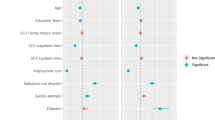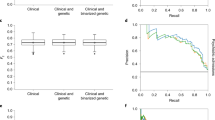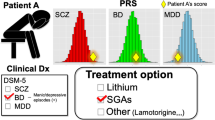Abstract
Genomic risk profile scores (GRPSs) have been shown to predict case–control status of schizophrenia (SCZ), albeit with varying sensitivity and specificity. The extent to which this variability in prediction accuracy is related to differences in sampling strategies is unknown. Danish population-based registers and Neonatal Biobanks were used to identify two independent incident data sets (denoted target and replication) comprising together 1861 cases with SCZ and 1706 controls. A third data set was a German prevalent sample with diagnoses assigned to 1773 SCZ cases and 2161 controls based on clinical interviews. GRPSs were calculated based on the genome-wide association results from the largest SCZ meta-analysis yet conducted. As measures of genetic risk prediction, Nagelkerke pseudo-R2 and variance explained on the liability scale were calculated. GRPS for SCZ showed positive correlations with the number of psychiatric admissions across all P-value thresholds in both the incident and prevalent samples. In permutation-based test, Nagelkerke pseudo-R2 values derived from samples enriched for frequently admitted cases were found to be significantly higher than for the full data sets (Ptarget=0.017, Preplication=0.04). Oversampling of frequently admitted cases further resulted in a higher proportion of variance explained on the liability scale (improvementtarget= 50%; improvementreplication= 162%). GRPSs are significantly correlated with chronicity of SCZ. Oversampling of cases with a high number of admissions significantly increased the amount of variance in liability explained by GRPS. This suggests that at least part of the effect of common single-nucleotide polymorphisms is on the deteriorative course of illness.
This is a preview of subscription content, access via your institution
Access options
Subscribe to this journal
Receive 12 print issues and online access
$259.00 per year
only $21.58 per issue
Buy this article
- Purchase on Springer Link
- Instant access to full article PDF
Prices may be subject to local taxes which are calculated during checkout

Similar content being viewed by others
References
Whiteford HA, Degenhardt L, Rehm J, Baxter AJ, Ferrari AJ, Erskine HE et al. Global burden of disease attributable to mental and substance use disorders: findings from the Global Burden of Disease Study 2010. Lancet 2013; 382: 1575–1586.
Saha S, Chant D, McGrath J . A systematic review of mortality in schizophrenia: is the differential mortality gap worsening over time? Arch Gen Psychiatry 2007; 64: 1123–1131.
Knapp M, Mangalore R, Simon J . The global costs of schizophrenia. Schizophr Bull 2004; 30: 279–293.
Lichtenstein P, Bjork C, Hultman CM, Scolnick E, Sklar P, Sullivan PF . Recurrence risks for schizophrenia in a Swedish national cohort. Psychol Med 2006; 36: 1417–1425.
Cardno AG, Gottesman II . Twin studies of schizophrenia: from bow-and-arrow concordances to star wars Mx and functional genomics. Am J Med Genet 2000; 97: 12–17.
Schizophrenia Working Group of the Psychiatric Genomics Consortium. Biological insights from 108 schizophrenia-associated genetic loci. Nature 2014; 511: 421–427.
Schizophrenia Psychiatric Genome-Wide Association Study Consortium. Genome-wide association study identifies five new schizophrenia loci. Nat Genet 2011; 43: 969–976.
Ripke S, O'Dushlaine C, Chambert K, Moran JL, Kahler AK, Akterin S et al. Genome-wide association analysis identifies 13 new risk loci for schizophrenia. Nat Genet 2013; 45: 1150–1159.
Ikeda M, Aleksic B, Kinoshita Y, Okochi T, Kawashima K, Kushima I et al. Genome-wide association study of schizophrenia in a Japanese population. Biol Psychiatry 2011; 69: 472–478.
International Schizophrenia C, Purcell SM, Wray NR, Stone JL, Visscher PM, O'Donovan MC et al. Common polygenic variation contributes to risk of schizophrenia and bipolar disorder. Nature 2009; 460: 748–752.
Dudbridge F . Power and predictive accuracy of polygenic risk scores. PLoS Genet 2013; 9: e1003348.
Wray NR, Yang J, Hayes BJ, Price AL, Goddard ME, Visscher PM . Pitfalls of predicting complex traits from SNPs. Nat Rev Genet 2013; 14: 507–515.
Cohen P, Cohen J . The clinician's illusion. Arch Gen Psychiatry 1984; 41: 1178–1182.
Laursen TM, Nordentoft M, Mortensen PB . Excess early mortality in schizophrenia. Annu Rev Clin Psychol 2014; 10: 425–448.
Agerbo E, Mortensen PB, Wiuf C, Pedersen MS, McGrath J, Hollegaard MV et al. Modelling the contribution of family history and variation in single nucleotide polymorphisms to risk of schizophrenia: a Danish national birth cohort-based study. Schizophr Res 2012; 134: 246–252.
Borglum AD, Demontis D, Grove J, Pallesen J, Hollegaard MV, Pedersen CB et al. Genome-wide study of association and interaction with maternal cytomegalovirus infection suggests new schizophrenia loci. Mol Psychiatry 2013; 19: 325–333.
Mors O, Perto GP, Mortensen PB . The Danish Psychiatric Central Research Register. Scand J Public Health 2011; 39: 54–57.
Lynge E, Sandegaard JL, Rebolj M . The Danish National Patient Register. Scand J Public Health 2011; 39: 30–33.
Pedersen CB . The Danish Civil Registration System. Scand J Public Health 2011; 39: 22–25.
Nordentoft M, Pedersen MG, Pedersen CB, Blinkenberg S, Mortensen PB . The new asylums in the community: severely ill psychiatric patients living in psychiatric supported housing facilities. A Danish register-based study of prognostic factors, use of psychiatric services, and mortality. Soc Psychiatry Psychiatr Epidemiol 2012; 47: 1251–1261.
Pedersen CB, Mors O, Bertelsen A, Waltoft BL, Agerbo E, McGrath JJ et al. A comprehensive nationwide study of the incidence rate and lifetime risk for treated mental disorders. JAMA Psychiatry 2014; 71: 573–581.
Allan CL, Cardno AG, Rijsdijk FV, Kalidindi S, Farmer A, Murray RM et al. Twin study of illness history variables in psychosis. Schizophr Res 2009; 115: 237–244.
Kendler KS, Karkowski-Shuman L, O'Neill FA, Straub RE, MacLean CJ, Walsh D . Resemblance of psychotic symptoms and syndromes in affected sibling pairs from the Irish Study of High-Density Schizophrenia Families: evidence for possible etiologic heterogeneity. Am J Psychiatry 1997; 154: 191–198.
Kakela J, Panula J, Oinas E, Hirvonen N, Jaaskelainen E, Miettunen J . Family history of psychosis and social, occupational and global outcome in schizophrenia: a meta-analysis. Acta Psychiatr Scand 2014; 130: 269–278.
Caseiro O, Perez-Iglesias R, Mata I, Martinez-Garcia O, Pelayo-Teran JM, Tabares-Seisdedos R et al. Predicting relapse after a first episode of non-affective psychosis: a three-year follow-up study. J Psychiatr Res 2012; 46: 1099–1105.
Lindstrom LH . Clinical and biological markers for outcome in schizophrenia: a review of a longitudinal follow-up study in Uppsala schizophrenia research project. Neuropsychopharmacology 1996; 14: 23S–26S.
Agerbo E, Sullivan PF, Vilhjalmsson BJ, Pedersen CB, Mors O, Børglum AD et al. Polygenic risk score, parental socioeconomic status, family history of psychiatric disorders and the risk of schizophrenia: a Danish population-based study. JAMA Psychiatry 2015; 72: 635–641.
McGrath JJ, Mortensen PB, Visscher PM, Wray NR . Where GWAS and epidemiology meet: opportunities for the simultaneous study of genetic and environmental risk factors in schizophrenia. Schizophr Bull 2013; 39: 955–959.
Schwartz S, Susser E . Genome-wide association studies: does only size matter? Am J Psychiatry 2010; 167: 741–744.
Schwartz S, Susser E . The use of well controls: an unhealthy practice in psychiatric research. Psychol Med 2011; 41: 1127–1131.
Reich T, James JW, Morris CA . The use of multiple thresholds in determining the mode of transmission of semi-continuous traits. Ann Hum Genet 1972; 36: 163–184.
Sorensen HJ, Larsen JT, Mors O, Nordentoft M, Mortensen PB, Petersen L . Analysis of risk factors for schizophrenia with two different case definitions: A nationwide register-based external validation study. Schizophr Res 2015; 162: 74–78.
Uggerby P, Ostergaard SD, Roge R, Correll CU, Nielsen J . The validity of the schizophrenia diagnosis in the Danish Psychiatric Central Research Register is good. Dan Med J 2013; 60: A4578.
Jakobsen KD, Frederiksen JN, Hansen T, Jansson LB, Parnas J, Werge T . Reliability of clinical ICD-10 schizophrenia diagnoses. Nord J Psychiatry 2005; 59: 209–212.
Acknowledgements
We are indebted to all individuals who have participated in, or helped with, our research. The Danish replication samples were genotyped at the Broad Institute and funded by Stanley Center for Psychiatric Research, Broad Institute and the Lundbeck Foundation, within the context of the Lundbeck Foundation Initiative for Integrative Psychiatric Research, iPSYCH. We acknowledge Kimberly Chambert and Christine Stevens for laboratory sample management. Dr Mortensen received further funding from the Stanley Medical Research Institute. The German SCZ GWAS sample received funding from the European Community's Seventh Framework Programme (FP7) under grant agreement n° 279227 (Crestar) and the German Federal Ministry of Education and Research (BMBF) through the Integrated Network IntegraMent (Integrated Understanding of Causes and Mechanisms in Mental Disorders) under the auspices of the e:Med Programme (grant 01ZX1314A to MMN, grant 01ZX1314G to MR). Dr Wray is funded by Australian National Health and Medical Research Council grants (1078901, 1047956). We thank the Schizophrenia Working Group of the Psychiatric Genomics Consortium for kindly providing us with the summary statistics of their data.
Author information
Authors and Affiliations
Consortia
Corresponding author
Ethics declarations
Competing interests
The authors declare no conflict of interest.
Additional information
Members of the MooDS SCZ Consortium
Department of Genetic Epidemiology in Psychiatry, Central Institute of Mental Health, Mannheim, Germany—Lang M, Strohmaier J, Meier SM, Frank J, Witt SH, Rietschel M; Department of Genomics, Life and Brain Center, and Institute of Human Genetics, University of Bonn, Bonn, Germany—Degenhardt F, Forstner AJ, Propping P, Hoffmann P, Schumacher J, Herms S, Cichon S, Nöthen MM; Institute of Psychiatric Phenomics and Genomics, Ludwig-Maximilians-University, Munich, Germany—Schulze TG; Department of Translational Research in Psychiatry, Max Planck Institute of Psychiatry, Munich, Germany—Müller-Mhysok B; Department of Psychiatry and Psychotherapy, Jena University Hospital, Jena, Germany—Schultz CC, Schlösser RGM, Nenadic I, Sauer H; Department of Psychiatry, University of Bonn, Bonn, Germany—Maier W; Department of Psychiatry, University of Halle-Wittenberg, Halle/Saale, Germany—Rujescu D, Giegling I.
Supplementary Information accompanies the paper on the Molecular Psychiatry website
Supplementary information
PowerPoint slides
Rights and permissions
About this article
Cite this article
Meier, S., Agerbo, E., Maier, R. et al. High loading of polygenic risk in cases with chronic schizophrenia. Mol Psychiatry 21, 969–974 (2016). https://doi.org/10.1038/mp.2015.130
Received:
Revised:
Accepted:
Published:
Issue Date:
DOI: https://doi.org/10.1038/mp.2015.130
This article is cited by
-
The genetic architecture of schizophrenia: review of large-scale genetic studies
Journal of Human Genetics (2023)
-
Role of polygenic and environmental factors in the co-occurrence of depression and psychosis symptoms: a network analysis
Translational Psychiatry (2022)
-
Associations between patterns in comorbid diagnostic trajectories of individuals with schizophrenia and etiological factors
Nature Communications (2021)
-
Global landscape and genetic regulation of RNA editing in cortical samples from individuals with schizophrenia
Nature Neuroscience (2019)
-
Durchbrüche im Verständnis der molekularen Ursachen psychiatrischer Störungen
Der Nervenarzt (2019)



